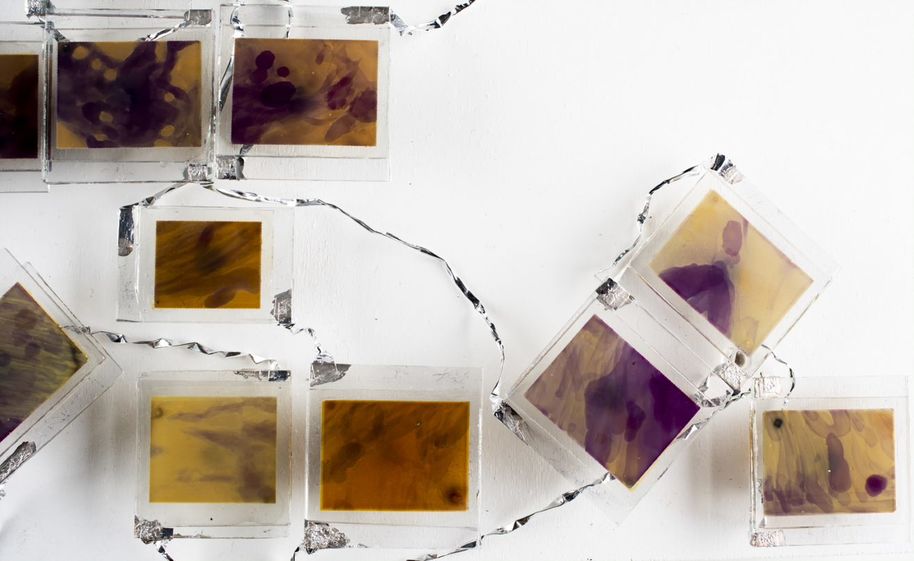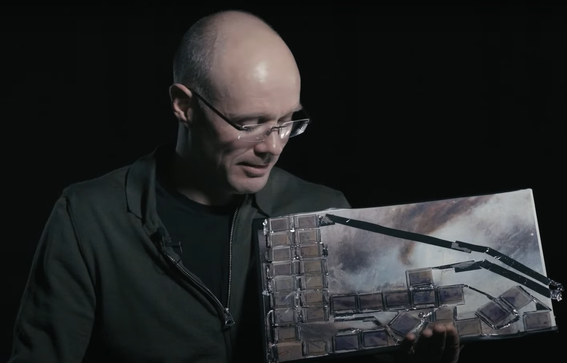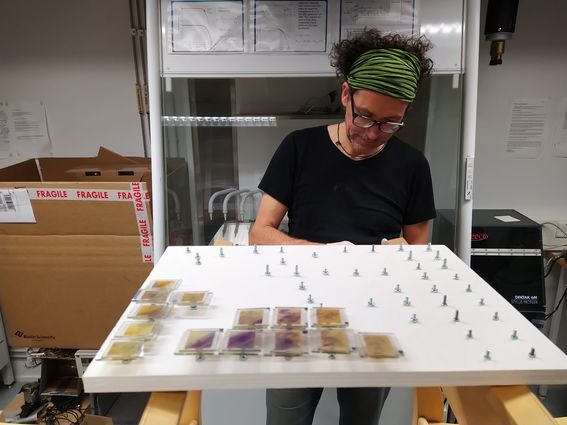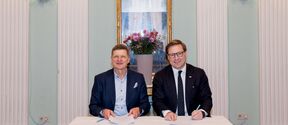How an exciting engineering challenge drew a physicist into solar painting

When Janne Halme took up research on solar power 20 years ago, this was not quite what he envisioned himself doing.
The project was overall unusual for a researcher: The objective was to produce a painting based upon William Turner’s painting Snow Storm, using colourants extracted from the Aronia melanocarpa plant, that would double as a solar panel. As typical engineering techniques failed to deliver the desired results, the university lecturer from Aalto University decided to take up unusual means.
‘I realized that I had been trapped in an engineering bubble that made no sense in the context of this project. Why should we even try to print the dyes when we could simply take a paint brush and paint them on the solar cells, like Turner did. We tried it and it worked perfectly.’
The result is Blck Vlvt, the world’s first hand-painted solar panel painting and one of several outcomes of collaboration between Halme’s research group and the artist Bartaku. The artwork is formed out of solar cells that mimic the rhythm and hues of Turner’s original painting.
The collaboration has made it possible to examine technology from an angle that the scientific race leaves no room for. As most researchers have moved on to study more efficient solar cell technologies than the dye-sensitized solar cells used in the painting, art provides the space for exploring the technique further.
‘This helps us ask broader questions about energy, efficiency and the use of raw materials in solar energy technology. For me, plant based solar energy art is an esthetically beautiful way to direct attention to central questions. It also brings to the limelight other life forms, in this case the Aronia plant used in the dyes which sets the limits for the painting. I feel we have established a particular connection with it through our work’, Halme says.
The collaboration does not aim for immediate and measurable gain, but opens up a new space for thinking - and perhaps leads to unexpected discoveries.
‘The solar panel is the medium that we work with, but through it, we might find something completely different - perhaps about biology, or molecules that work inside the painting. Or about our attitude towards utilizing other species in technology. This way art can help science broaden its own boundaries’, Bartaku contemplates.

Exceptionally long-lasting collaboration
The cooperation began already in 2016, as the artist working on his PhD at Aalto invited the physicist into his class to talk about solar panels. During the collaboration that followed, several other people have been involved, Halme and Bartaku however continue to form the nucleus of the collaboration.
‘We are one of the few examples in this whole practice of transdisciplinarity where this kind of bottom-up, long-durational collaboration is happening. Very often, these collaborations are project based and of limited time’, Bartaku says.
Now, they are working on the Painting energies podcast which discusses questions that arose as Blck Vlvt was made — relating to light, colors, plants, microbes and electric energy, as well as our relationship to those in dialogue with science, technology, art, and philosophy. Four of the eleven episodes are currently available online.
Janne HalmeArtistic work can enrich a scientist's thinking and bring new creativity and joy to it.
Blck Vlvt, on the other hand, has been showcased at Aalto as part of the Towardless exhibition. Last fall it was also presented in the X-Festival 2021 at Hasselt University, Belgium. Bartaku and Halme hope that the artwork will find its way to other exhibitions, too. In addition, they are planning a touring exhibition where they would broaden the concept already featured at the Towardless exhibition where Halme and Bartaku presented their old research objects; for instance, Halme’s first and already disintegrated solar panels.
‘We would like to invite researchers to open their archives and exhibit their research objects to the public. According to my inquiries, most researchers have thrown away their work as chemical waste. That is a shame, as researchers themselves might realize their relevance only after they have lost them’, Halme says.

He has a humoristic theory about why this is.
‘They are ashamed! It would show that their solar cells are actually tiny!’
More seriously, he contemplates:
“Science does not need to be so serious. The problems that we work to solve are themselves already gloomy enough, and gloominess restricts thinking. I have now personally experienced how greatly artistic work can enrich a scientist’s thinking and bring new creativity and joy to it. I hope other researchers get to experience it, too.’
Blck Vlvt is part of Bartaku’s doctoral dissertation Baroa belaobara: berryapple that was accepted in June 2021.
Blck Vlvt was exhibited at Aalto in the Outré Bioart exhibition 2020, and at the Designs for a Cooler Planet exhibition in September 2021. The electricity produced by the solar panel was directed to an LED light in a dark tent where it lit up a replica of the original Turner painting. The whole name of the original painting is Snow Storm – Steam-Boat off a Harbour's Mouth Making Signals in Shallow Water, and going by the Lead. The Author was in this Storm on the Night the "Ariel" left Harwich (Exh. 1842).
Contact information
Janne Halme
University Lecturer
janne.halme@aalto.fi
+358503441695
Read more news

The semiconductor sector jobs open in research groups
Semi-Summer 2026 programme will provide an opportunity to gain the skills needed in a growing and international semiconductor sector.
New cooperation agreement between the City of Helsinki and Aalto University to strengthen a sustainable, vibrant and knowledgeable city
The main themes of the cooperation are vitality, innovations and entrepreneurship, as well as research cooperation and knowledgeable labour, drawing heavily on the research and education expertise of the university.
Aalto Inventors innovation training coming for hydrogen, quantum and microelectronics researchers this spring
Connect with industry and academic thought-leaders and gain widely applicable skills in communication, intellectual property, and business.






